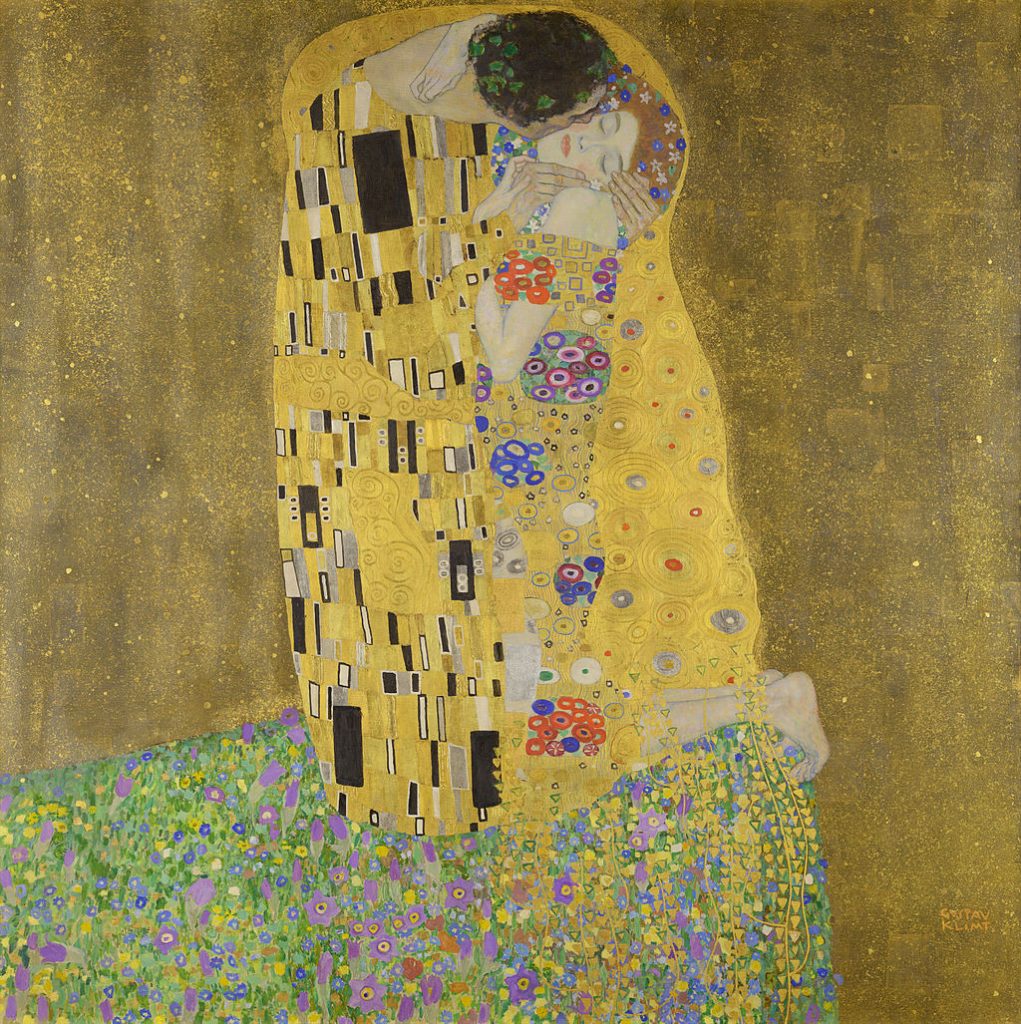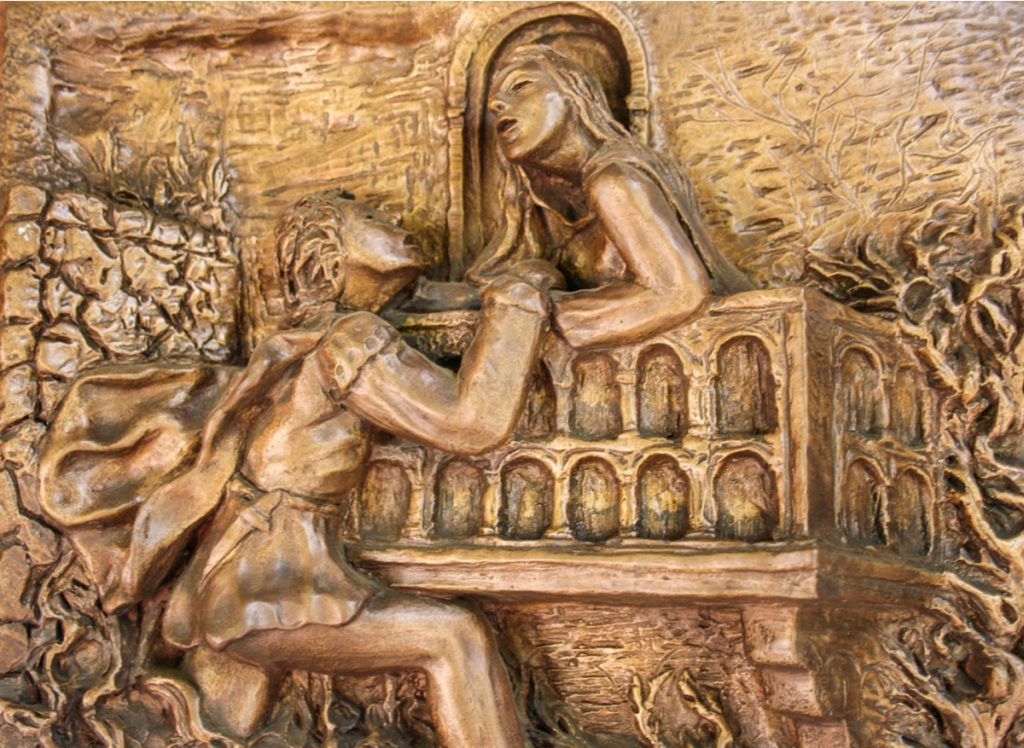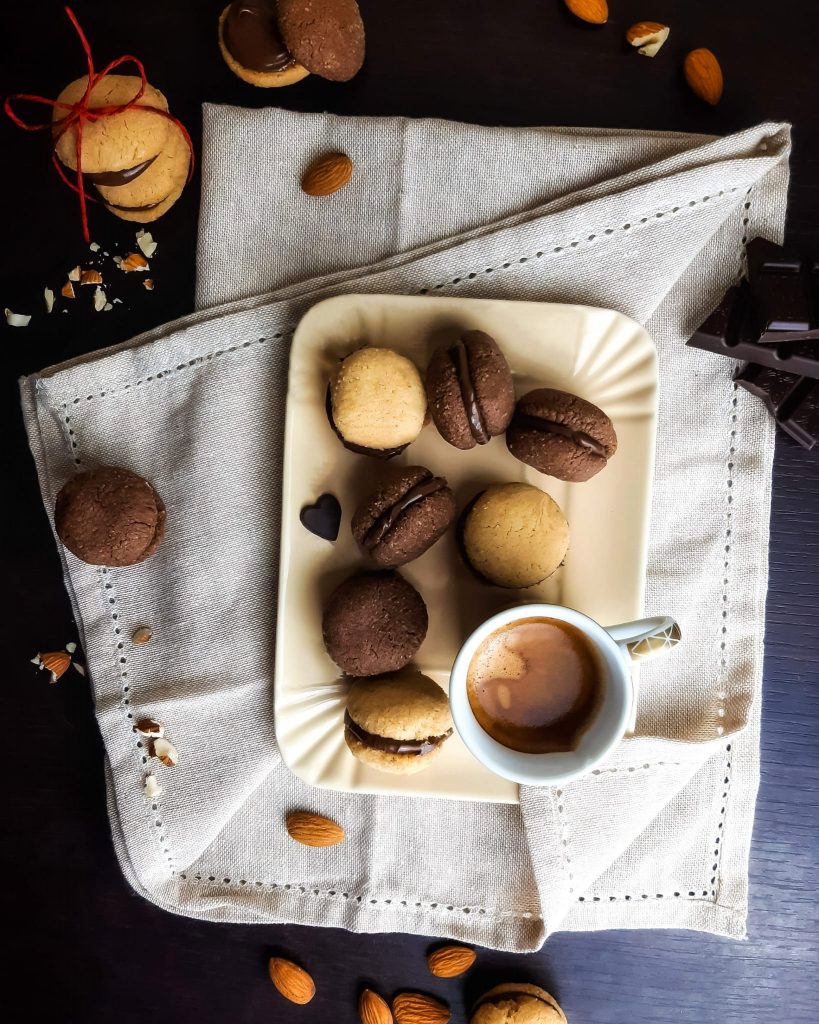Un bacio, che cos’è mai un bacio? “Un apostrofo rosa fra le parole t’amo” diceva Cyrano de Bergerac. Per me è come l’espolsione di un tappo di champagne, due anime si sognano, si desiderano fino ad esplodere in un bacio, l’aria è frizzante e i cuori in festa.
Scroll down to read this article and recipe for “Kisses of Romeo and Juliet” in English.
Personale e istintiva l’interpretazione di un bacio, una delle senzazioni più potenti che possiamo provare, nel corso dei secoli infatti è stato fonte di ispirazione per ogni forma d’arte; opere letterarie, poesie, canzoni, quadri, film e favole; ma c’è pure un altro ambito in cui i baci sono protagonisti, ovvero la pasticceria. In Italia sono numerosi i dolci ispirati al bacio, a partire dai “baci di dama” piemontesi, biscotti di frolla alle mandorle nati nelle cucine reali di casa Savoia con una forma somigliante le labbra di una fanciulla intenta a dare un bacio, da qui il loro nome particolare.
© MyWoWo Travel App
In Umbria possiamo trovare invece i “baci Perugina” famosi cioccolatini contenenti frasi d’amore, pubblicizzati con l’ immagine di due innamorati, rielaborazione del dipinto “il bacio” del pittore italiano Francesco Hayez. Probabilmente ideati da Luisa Spagnoli, proprietaria, con il marito di una drogheria a Perugia, che sarebbe poi divenuta la Perugina. Inizialmente sarebbero nati per utilizzare i frammenti di nocciola che dovevano essere recuperati ma il loro successo fu tale da divenire un prodotto apprezzato e conosciuto in tutto il mondo.
Degni di nota anche i baci panteschi, dolcetti tipici di Pantelleria, la meravigliosa isola siciliana. Quest’isola è ricca di tradizioni antiche ed una di queste è proprio il bacio pantesco, un piccolo dolcetto fritto ripieno di ricotta e scaglie di cioccolato. Questo dolcetto è facilmente riconoscibile dalla forma a stella o fiore e si ottiene utilizzando un apposito stampo.

Tante le ricette ispirate al bacio in tutto il paese, ma la mia scelta oggi ci porta in Veneto, precisamente a Verona; Teatro del dramma shakespeariano di Romeo e Giulietta, la storia d’amore più famosa del mondo raccontata in tutte le forme, dai dipinti di Frank Dicksee e Gustav Klimt alle oltre quaranta versioni cinematografiche, tra le quali il film premio oscar di Franco Zeffirelli. Innumerevoli anche le riduzioni musicali come il poema sinfonico di Čajkovskij, i balletti di Prokof’ev e di Kenneth MacMillan, e le opere teatrali come quelle di Gounod e Bellini.
Una storia d’amore dal fortissimo impatto emotivo dove i due protagonisti hanno assunto nel tempo un valore simbolico, diventando l’archetipo dell’amore perfetto, ma avversato dalla società e dalle famiglie. Montecchi e Capuleti, la loro rivalità era già nota nel Trecento, citata pure da Dante nella sua “Commedia”. Solo i Montecchi sono originari di Verona, mentre i Capuleti (che in realtà si chiamavano Cappelletti) provengono da Cremona, anche li troviamo pure a Verona fino agli anni della permanenza di Dante, nell’odierna casa di Giulietta, dove la loro presenza è testimoniata anche dallo stemma del cappello sulla chiave di volta dell’arco di entrata al cortile dell’edificio duecentesco. Il contesto storico di Dante non fa comunque riferimento alle vicende dell’amore contrariato tra gli amanti di queste famiglie, perciò merito di Shakespeare, se ancora oggi sogniamo un amore forte e romantico come quello dei due giovanissimi amanti.
Anche se in verità Shakespeare non ha inventato questa storia, la vicenda di questi due innamorati era già stata raccontata, in passato da più di una persona. Per scrivere la sua tragedia più famosa, Il nostro drammaturgo si è ispirato a componimenti letterari del passato e con ogni probabilità, la sua fonte d’ispirazione può essere stata una novella italiana, una leggenda senese del basso medioevo, riscritta da Masuccio Salernitano, uno dei maggiori scrittori italiani del ‘400, col titolo: “I due amanti senesi” o una novella subito successiva di Luigi Da Porto, nobile vicentino che scrisse la “Istoria novellamente ritrovata di due nobili amanti”.
Un racconto quindi, esistente da tempo immemore, reso universale da Shakespeare e ambientato nella splendida cornice della città di Verona che ai due innamorati dedica un dolce, “i baci di Romeo e Giulietta”, sono dei dolcetti tipici che in occasione della festa degli innamorati, vengono regalati al proprio amore in un sacchetto chiuso da un nastro rosso.

Gli uomini regalano alla loro amata i “Baci di Giulietta”, le donne regalano al loro amato i “Baci di Romeo”. Questi dolcetti sono dei friabilissimi biscotti di nocciole e mandorle (nella versione di Romeo vogliono l’aggiunta di cacao), che vengono uniti da una ganache al cioccolato fondente.
Presenti praticamente in ogni pasticceria della città, sono di grande attrattiva non solo per le coppie ma anche per i turisti che difficilmente desistono dall’aquistarli, sono squisiti e di sicuro sono un ottimo modo per conquistare la persona amata.
Inutile dire che mi hanno conquistato, quindi ho deciso di provare la icotta.

Baci di Giulietta
Ingredienti
• 150 gr di zucchero
• 200 gr di mandorle
• 125 gr di nocciole
• 150 gr di farina di riso
• 150 gr di burro freddo di frigo
• 1/2 cucchiaino di lievito per dolci
• 1 tuorlo
Baci di Romeo
Ingredienti
• 30 gr di cacao amaro in polvere
• 150 gr di zucchero
• 200 gr di mandorle
• 125 gr di nocciole
• 150 gr di farina di riso
• 150 gr di burro freddo di frigo
• 1/2 cucchiaino di lievito per dolci
• 1 tuorlo
Ganache al cioccolato
Ingredienti
• 400 gr di cioccolato fondente
• 300 gr di panna fresca
• 150 gr di zucchero
• 80 gr di burro
Procedimento
Baci di Giulietta
Nel bicchiere del frullatore versare le mandorle e le nocciole, ed azionare fino ad ottenere una farina fine ma senza scaldare la frutta secca che altrimenti tirerebbe fuori troppo olio.
Unire alla farina così ottenuta la farina di riso, lo zucchero ed il lievito in polvere, e mescolare bene.
Aggiungere il burro fresco tagliato in piccoli pezzi ed azionare nuovamente il frullatore fino ad ottenere un composto sabbioso.
Infine, unire il tuorlo e amalgamare bene.
Ottenuto un composto compatto e morbido, coprire e lasciarlo riposare in frigo per 10-15 minuti.
Riprendere il composto e inserirlo nella sac a poche con beccuccio a stella, e formare sulla teglia coperta da carta forno dei petit four della grandezza di una noce. In alternativa, prelevare a mano poco impasto alla volta e formare delle palline.
Cuocere in forno già caldo, modalità statica, a 160°C per 20 minuti, fino a leggera doratura.
Lasciar raffreddare i dolcetti completamente prima di procedere con la farcia.
Baci di Romeo
Procedere come per i dolcetti di Giulietta, aggiungendo il cacao amaro insieme agli ingredienti secchi.
Ganache al cioccolato
In un pentolino versare la panna con lo zucchero e scaldare fino a sfiorare il bollore. Abbassare la fiamma ed unire il burro ed il cioccolato fondente e lasciar sciogliere completamente.
Emulsionare il composto così ottenuto con un minipimer e lasciar raffreddare prima di farcire i dolcetti.
Una volta raffreddati sia i dolcetti che la ganache, sulla parte piatta di un biscottino distribuire della ganache e unire con un altro biscottino.
Lasciar solidificare prima di servire i baci di Romeo e Giulietta o prima di inserirli in un sacchetto con il nastrino rosso che potrete lasciare in cucina per la vostra dolce metà, magari insieme a un buon caffè.
Trova altre ricette:
Capesante al timo con crema di patate allo zafferano
Baci di Romeo e Giulietta (Kisses of Romeo and Juliet)
A kiss, what is a kiss? “A pink apostrophe between the words I love you,” said Cyrano de Bergerac. For me, it’s like the release of a Champagne cork: two souls dream of each other; want each other until they explode in a kiss. The air is sparkling and their hearts full of joy.
The kiss, one of the most powerful sensations we can experience has been for centuries, a source of inspiration for every art form: literary works, poems, songs, paintings, films and fairy tales.
However, kisses are also the protagonist of another art: pastry-making. In Italy, there are numerous desserts inspired by the bacio (the kiss) starting from the Piedmontese baci di dama, shortcrust biscuits with almonds born in the royal kitchens of the House of Savoy. The name means lady’s kisses from the shape reminiscent of two lips kissing.
In Umbria you can find the famous baci Perugina, chocolates containing small messages of love advertised with the image of two lovers. It is a reproduction of Italian artist, Francesco Hayez’ painting Il Bacio (The Kiss, 1859: Pinacoteca di Brera, Milan.) The idea was probably conceived by Luisa Spagnoli who with her husband own a grocery store in Perugia, later renamed Perugina. Their initial idea was to reuse hazelnut leftovers. However, the baci Perugina’s success made it a product appreciated and known all over the world.
Also noteworthy are the baci panteschi, a sweet pastry typical of Pantelleria, a wonderful Sicilian island. This island is rich in ancient traditions and one is the Bacio Pantesco, a small fried pastry filled with ricotta and chocolate flakes. These fritters are easily recognizable by their star or flower shape and are made using a special mold.
Many recipes are inspired by kisses throughout the country, but my choice today takes us to Veneto and precisely to Verona: set of the Shakespearean drama, Romeo and Juliet. The most famous love story in the world has been told in all forms — from paintings by Frank Dicksee and Gustav Klimt to over forty film versions, including the Oscar-winning film by Franco Zeffirelli.
There are also countless musical compositions such as Tchaikovsky’s Symphonic Poem; ballets by Prokofiev and Kenneth MacMillan; and plays such as those by Gounod and Bellini.
The two protagonists have become emblematic over time and their love story, opposed by society and families, has become the archetype of perfect love. The rivalry between the Montagues and the Capulets, already known in the 14th century, were also mentioned by Dante in his “Commedia.” While the Montagues are originally from Verona, the Capulets came from Cremona. They could be found in Verona up to the years of Dante’s stay, in what we know today as Juliet’s house. In the keystone the 13th-century building’s entrance arch is carved a hat, the family’s coat of arms. However, Dante does not refer to the tragic love between the two lovers.
It is thanks to Shakespeare that we still dream of an intense and romantic love like that of the two young lovers although in truth, Shakespeare did not invent the story. To write his most famous tragedy, the playwright was inspired by literary compositions of the past. Most likely, his source of inspiration may have been the Italian short story, The Two Sienese Lovers a Sienese legend from the late Middle Ages rewritten by Masuccio Salernitano–one of the greatest Italian writers of the 15th century. Or an ensuing short story by Luigi Da Porto, a noble from Vicenza who wrote the Newly Found Story of Two Noble Lovers.
Therefore, an ancient tale became universal through Shakespeare and set in the splendid setting of the city of Verona. Plus, a sweet treat dedicated to the two lovers. “The Kisses of Romeo and Juliet,” is a typical dessert made on Valentine’s Day and given to the loved one. They are wrapped in a bag that is tied with a red ribbon.
Men give their beloved the Juliet’s Kisses, while women present the Romeo’s Kisses. These sweets are very crumbly, hazelnut and almond biscuits that are joined by a dark chocolate ganache. In Romeo’s version, cocoa is added to the biscuit dough.
Today, in practically every pastry shop in the city, they are a great attraction not only for couples, but also for tourists who can’t resist buying them. They are exquisite and for sure are a great way to conquer the loved one.
Needless to say, I am hooked and so I decided to try the recipe!
Baci di Giulietta (Juliet’s Kisses)
Ingredients
• 150 grams of sugar
• 200 grams of almonds
• 125 grams of hazelnuts
• 150 grams of rice flour
• 150 grams of cold butter from the fridge
• 1/2 teaspoon of baking powder
• 1 yolk
Romeo’s Kisses
Ingredients
• 30 grams of unsweetened cocoa powder
• 150 grams of sugar
• 200 grams of almonds
• 125 grams of hazelnuts
• 150 grams of rice flour
• 150 gr of cold butter from the fridge
• 1/2 teaspoon of baking powder
• 1 yolk
Chocolate Ganache
Ingredients
• 400 grams of dark chocolate
• 300 grams of fresh cream
• 150 grams of sugar
• 80 grams of butter
Method
Juliet’s Kisses
Put almonds and hazelnuts in the glass of the blender and operate until you get a fine flour but without heating the dried fruit that otherwise would draw out too much oil.
Add the rice flour, sugar and baking powder to the flour and mix well.
Add the fresh butter cut into small pieces and blend again to obtain a sandy mixture.
Finally, add the yolk and mix well.
Once you have a compact and soft mixture, cover and let it rest in the fridge for 10-15 minutes.
Take out the mixture and place it in the sac a poche with a star spout, and form petit fours the size of a walnut on the baking sheet covered with parchment paper. Alternatively, pick up a little dough by hand and shape into balls.
Bake in a preheated oven, static mode, at 160 C for 20 minutes, until lightly browned.
Allow the biscuits to cool completely before proceeding with the filling.
Romeo’s Kisses
Proceed as for Juliet’s kisses, adding the bitter cocoa together with the dry ingredients.
Method: Chocolate Ganache
In a saucepan pour the cream with the sugar and heat until it is almost boiling. Lower the heat and add the butter and dark chocolate and let it melt completely.
Emulsify the mixture thus obtained with a blender and let it cool before filling the biscuits.
Once both the kisses and the ganache have cooled, spread some ganache on the flat part of a biscuit and combine with another biscuit.
Let solidify before serving Romeo and Juliet’s kisses or before putting them in a bag with a red ribbon that you can leave in the kitchen for your sweetheart, perhaps together with a good coffee.

